A High-Resolution Sea Ice Concentration Retrieval from Ice-WaterNet Using Sentinel-1 SAR Imagery in Fram Strait, Arctic
Abstract
Highlights
- We propose Ice-WaterNet, a novel superpixel-based deep learning framework that effectively reduces classification uncertainty in complex melt season conditions by integrating CRF and a dual-attention U-Net mechanism.
- The model is validated on 2735 Sentinel-1 SAR images from 2021–2023 in the Fram Strait, demonstrating superior performance over state-of-the-art methods in both winter and summer seasons across multiple evaluation metrics.
- This study indicates the critical need to develop high-resolution SAR-based products, which can more accurately capture fine-grained spatiotemporal melt characteristics and provide reliable data for climate change research and sea ice trend analysis.
- By revealing the limitations of passive microwave sensors in assessing melt conditions, this study emphasizes that high-resolution SIC retrieval is essential to reduce underestimation errors and support operational applications such as maritime navigation and polar environment monitoring with improved spatial and temporal precision.
Abstract
1. Introduction
- (1)
- We introduce the uncertainty concept into ice–water classification during the melt season and propose a deep learning model for calculating uncertainty using a posteriori probabilities from the CRF, which can maintain high certainty in varying floe sizes and a variety of thin ice appearances.
- (2)
- We propose an effective superpixel-based U-Net named the Ice-WaterNet for SIC retrieval using 2735 Sentinel-1 images during 2021–2023 in Fram Strait. Comparison of typical algorithms for ML and DL on two datasets span winter and summer.
- (3)
- This paper discusses the SIC products derived from multiple sensors, including SAR, AMSR2, and Special Sensor Microwave Imager (SSMI). It has been found that traditional SIC products significantly underestimate the extent and degree of sea ice melt. Therefore, there is a pressing need to develop high-resolution SIC products to more accurately capture the characteristics and spatiotemporal trends of sea ice melt.
2. Study Area and Data
2.1. Study Area
2.2. Training and Testing Samples Dataset
2.2.1. Sample Patches for Model Training, Validating, and Testing
2.2.2. Image Dataset for Validating Ice–Water Classification Results
3. Methodology
3.1. Overview
3.2. Preprocessing of Sentinel-1 Imagery
3.3. Uncertain Superpixels Segmentation Based on CRF
3.4. Modeling the U-Net Attention Mechanism
3.5. Base Configuration Used in the Experiment
3.6. Evaluation Metrics
4. Results and Discussion
4.1. Experimental Results Quantitative Comparison During Melt Season and Freeze Season
4.2. Visual Performance Comparison of Ice–Water Classification Results
4.3. Ice–Water Classification Results and SIC on Each Sentinel-1 Scene Data
4.4. Time Series Analysis of SIC in Fram Strait
5. Conclusions
Author Contributions
Funding
Data Availability Statement
Acknowledgments
Conflicts of Interest
References
- Asadi, N.; Scott, K.A.; Komarov, A.S.; Buehner, M.; Clausi, D.A. Evaluation of a Neural Network with Uncertainty for Detection of Ice and Water in SAR Imagery. IEEE Trans. Geosci. Remote Sens. 2021, 59, 247–259. [Google Scholar] [CrossRef]
- Chen, X.; Cantu, F.J.P.; Patel, M.; Xu, L.; Brubacher, N.C.; Scott, K.A.; Clausi, D.A. A comparative study of data input selection for deep learning-based automated sea ice mapping. Int. J. Appl. Earth Obs. Geoinf. 2024, 131, 103920. [Google Scholar] [CrossRef]
- Wu, A.; Che, T.; Li, X.; Zhu, X. Routeview: An intelligent route planning system for ships sailing through Arctic ice zones based on big Earth data. Int. J. Digit. Earth 2022, 15, 1588–1613. [Google Scholar] [CrossRef]
- Huang, Z.; Yao, X.; Liu, Y.; Dumitru, C.O.; Datcu, M.; Han, J. Physically explainable CNN for SAR image classification. ISPRS J. Photogramm. Remote Sens. 2022, 190, 25–37. [Google Scholar] [CrossRef]
- Ivanova, N.; Pedersen, L.T.; Tonboe, R.T.; Kern, S.; Heygster, G.; Lavergne, T.; Sørensen, A.; Saldo, R.; Dybkjær, G.; Brucker, L.; et al. Inter-comparison and evaluation of sea ice algorithms: Towards further identification of challenges and optimal approach using passive microwave observations. Cryosphere 2015, 9, 1797–1817. [Google Scholar] [CrossRef]
- Chi, J.; Kim, H.C.; Lee, S.; Crawford, M.M. Deep learning based retrieval algorithm for Arctic sea ice concentration from AMSR2 passive microwave and MODIS optical data. Remote Sens. Environ. 2019, 231, 111204. [Google Scholar] [CrossRef]
- Jiang, L.; Chen, F.; Yu, D.; Ma, Y.; Zhao, D.; An, D. Automatic High-Accuracy Sea Ice Monitoring in the Arctic Using MODIS Data. IEEE Trans. Geosci. Remote Sens. 2023, 61, 4301413. [Google Scholar] [CrossRef]
- Li, X.; Xiong, C. Estimating Sea Ice Concentration from Microwave Radiometric Data for Arctic Summer Conditions using Machine Learning. IEEE Trans. Geosci. Remote Sens. 2024, 62, 4301018. [Google Scholar] [CrossRef]
- Cooke, C.L.V.; Scott, K.A. Estimating Sea Ice Concentration from SAR: Training Convolutional Neural Networks with Passive Microwave Data. IEEE Trans. Geosci. Remote Sens. 2019, 57, 4735–4747. [Google Scholar] [CrossRef]
- Karvonen, J. Baltic sea ice concentration estimation based on C-band HH-polarized SAR data. IEEE J. Sel. Top. Appl. Earth Obs. Remote Sens. 2012, 5, 1874–1884. [Google Scholar] [CrossRef]
- Karvonen, J. Baltic Sea Ice Concentration Estimation from C-Band Dual-Polarized SAR Imagery by Image Segmentation and Convolutional Neural Networks. IEEE Trans. Geosci. Remote Sens. 2021, 60, 4301411. [Google Scholar] [CrossRef]
- Huang, L.; Qiu, Y.; Li, Y.; Yu, S.; Zhong, W.; Dou, C. DynIceData: A gridded ice–water classification dataset at short-time intervals based on observations from multiple satellites over the marginal ice zone. Big Earth Data 2023, 8, 249–273. [Google Scholar] [CrossRef]
- Zhu, T.; Li, F.; Heygster, G.; Zhang, S. Antarctic Sea-Ice Classification Based on Conditional Random Fields from RADARSAT-2 Dual-Polarization Satellite Images. IEEE J. Sel. Top. Appl. Earth Obs. Remote Sens. 2016, 9, 2451–2467. [Google Scholar] [CrossRef]
- Khaleghian, S.; Ullah, H.; Kraemer, T.; Eltoft, T.; Marinoni, A. Deep Semisupervised Teacher-Student Model Based on Label Propagation for Sea Ice Classification. IEEE J. Sel. Top. Appl. Earth Obs. Remote Sens. 2021, 14, 10761–10772. [Google Scholar] [CrossRef]
- Wang, L.; Scott, K.A.; Clausi, D.A. Sea ice concentration estimation during freeze-up from SAR imagery using a convolutional neural network. Remote Sens. 2017, 9, 408. [Google Scholar] [CrossRef]
- Ren, Y.; Li, X.; Yang, X.; Xu, H. Development of a Dual-Attention U-Net Model for Sea Ice and Open Water Classification on SAR Images. IEEE Geosci. Remote Sens. Lett. 2022, 19, 4010205. [Google Scholar] [CrossRef]
- Wang, Q.; Lohse, J.P.; Doulgeris, A.P.; Eltoft, T. Data Augmentation for SAR Sea Ice and Water Classification Based on Per-Class Backscatter Variation with Incidence Angle. IEEE Trans. Geosci. Remote Sens. 2023, 61, 4205915. [Google Scholar] [CrossRef]
- Mahmud, M.S.; Nandan, V.; Singha, S.; Howell, S.E.L.; Geldsetzer, T.; Yackel, J.; Montpetit, B. C- and L-band SAR signatures of Arctic sea ice during freeze-up. Remote Sens. Environ. 2022, 279, 113129. [Google Scholar] [CrossRef]
- Zhang, T.; Yang, Y.; Shokr, M.; Mi, C.; Li, X.M.; Cheng, X.; Hui, F. Deep learning based sea ice classification with gaofen-3 fully polarimetric sar data. Remote Sens. 2021, 13, 1452. [Google Scholar] [CrossRef]
- Zhao, L.; Xie, T.; Perrie, W.; Yang, J. Deep-Learning-Based Sea Ice Classification with Sentinel-1 and AMSR-2 Data. IEEE J. Sel. Top. Appl. Earth Obs. Remote Sens. 2023, 16, 5514–5525. [Google Scholar] [CrossRef]
- Huang, R.; Wang, C.; Li, J.; Sui, Y. DF-UHRNet: A Modified CNN-Based Deep Learning Method for Automatic Sea Ice Classification from Sentinel-1A/B SAR Images. Remote Sens. 2023, 15, 2448. [Google Scholar] [CrossRef]
- Park, J.W.; Korosov, A.A.; Babiker, M.; Won, J.S.; Hansen, M.W.; Kim, H.C. Classification of sea ice types in Sentinel-1 synthetic aperture radar images. Cryosphere 2020, 14, 2629–2645. [Google Scholar] [CrossRef]
- Bi, H.; Sun, K.; Zhou, X.; Huang, H.; Xu, X. Arctic Sea Ice Area Export Through the Fram Strait Estimated from Satellite-Based Data: 1988–2012. IEEE J. Sel. Top. Appl. Earth Obs. Remote Sens. 2016, 9, 3144–3157. [Google Scholar] [CrossRef]
- Mladenova, I.E.; Jackson, T.J.; Bindlish, R.; Hensley, S. Incidence angle normalization of radar backscatter data. IEEE Trans. Geosci. Remote Sens. 2013, 51, 1791–1804. [Google Scholar] [CrossRef]
- Zhang, Y.; Zhu, T.; Spreen, G.; Melsheimer, C.; Huntemann, M.; Hughes, N.; Zhang, S.; Li, F. Sea ice and water classification on dual-polarized Sentinel-1 imagery during melting season. Cryosphere Discuss. 2021, 2021, 1–26. [Google Scholar]
- Li, J.; He, W.; Cao, W.; Zhang, L.; Zhang, H. UANet: An Uncertainty-Aware Network for Building Extraction from Remote Sensing Images. IEEE Trans. Geosci. Remote Sens. 2024, 62, 5608513. [Google Scholar] [CrossRef]
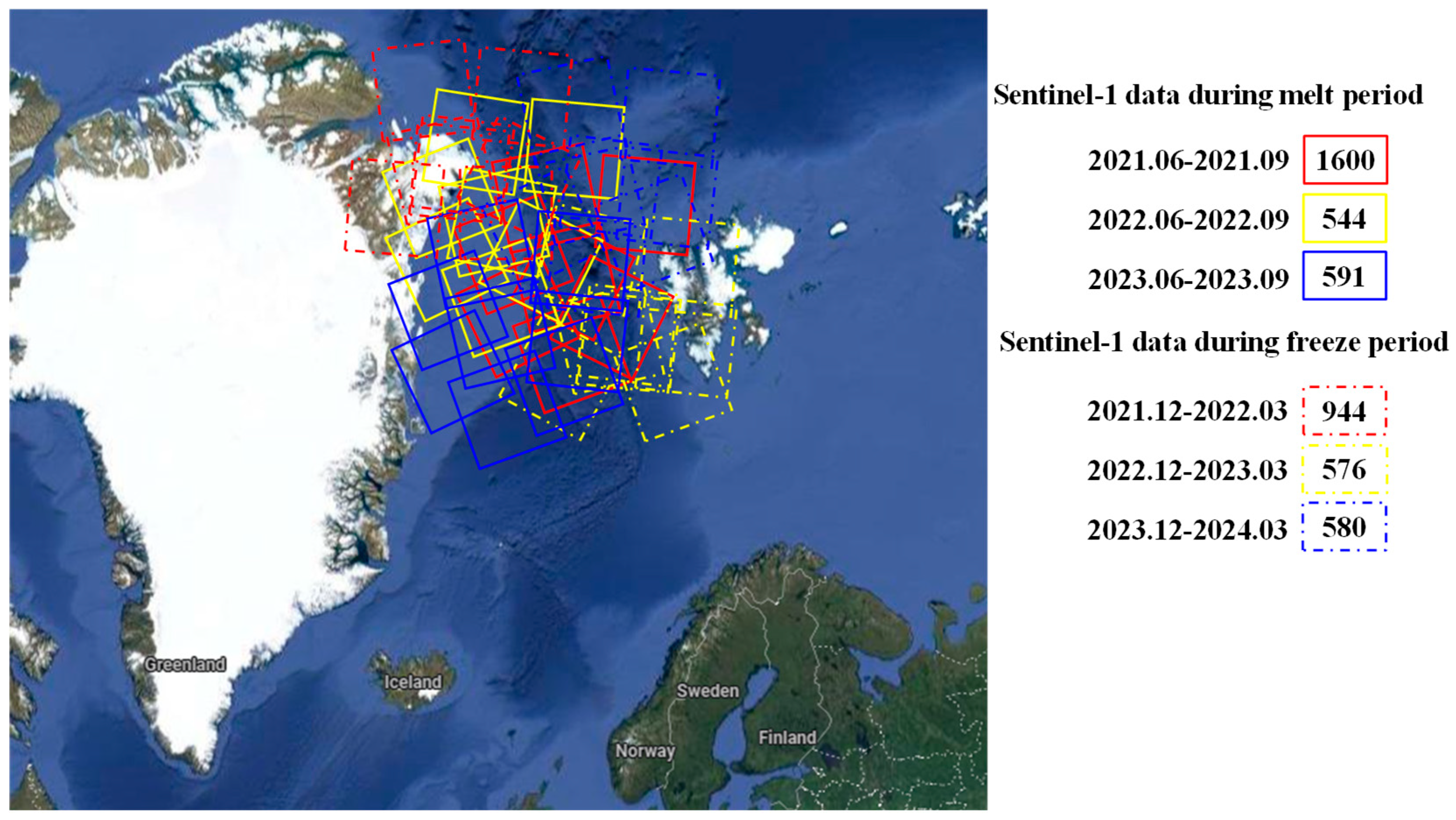
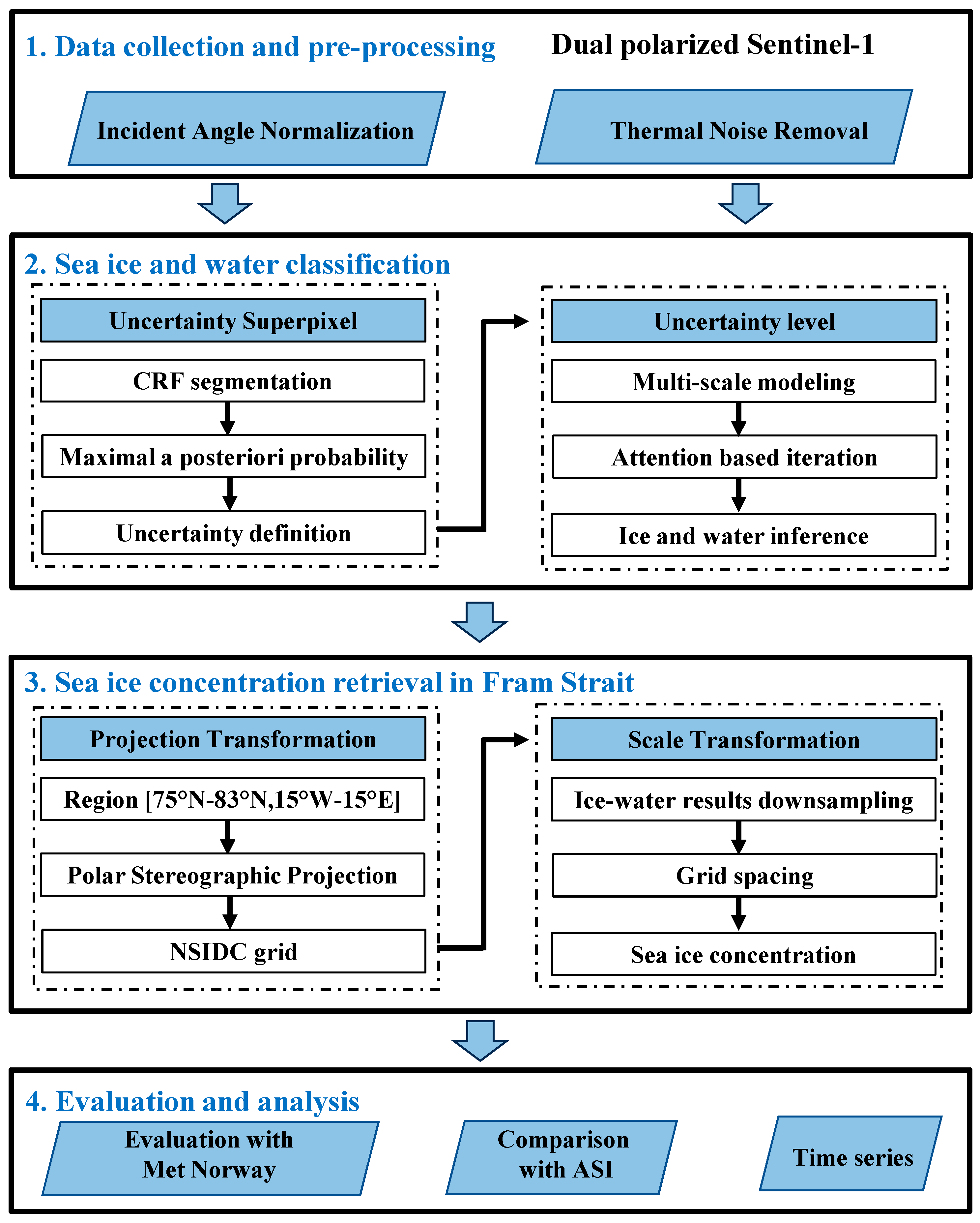

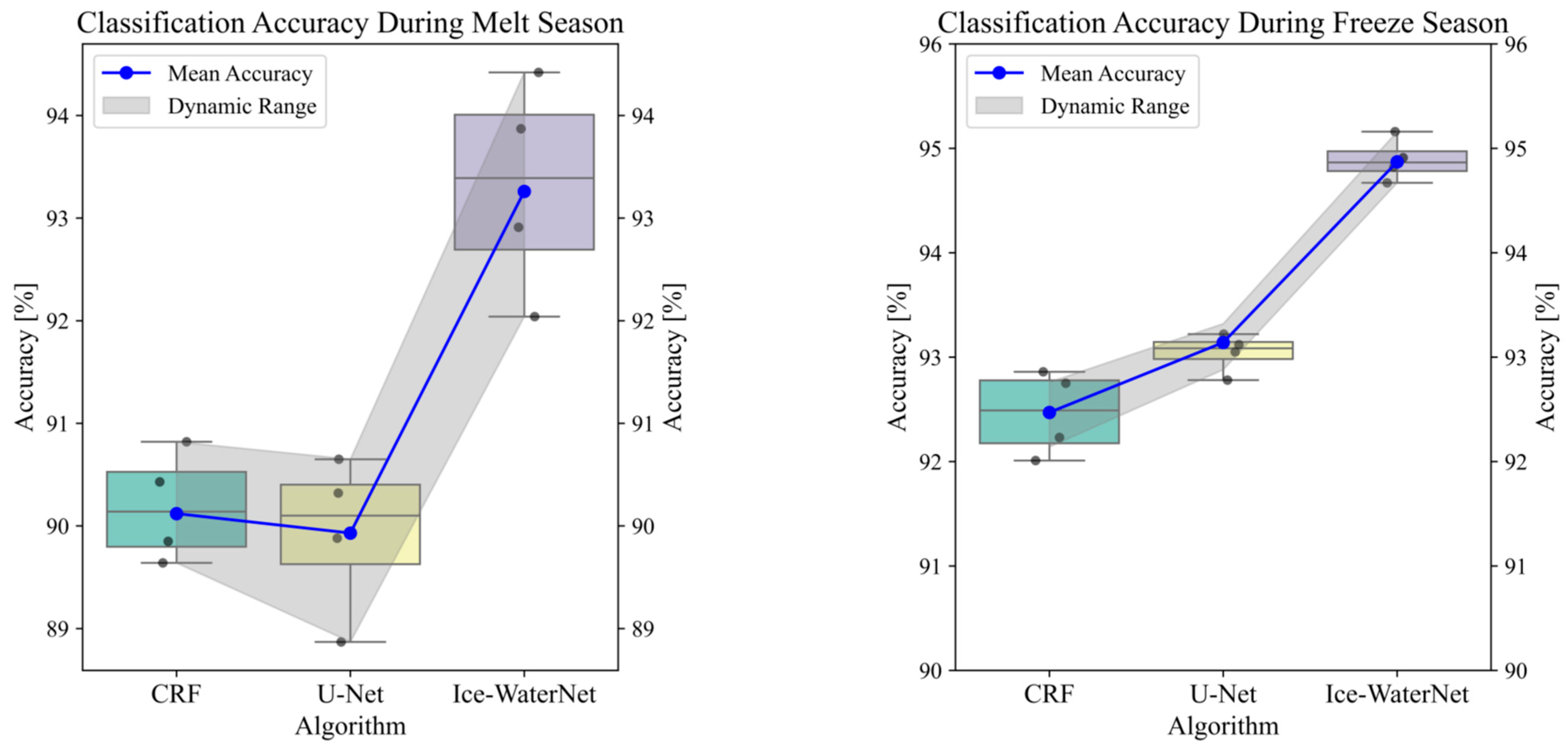
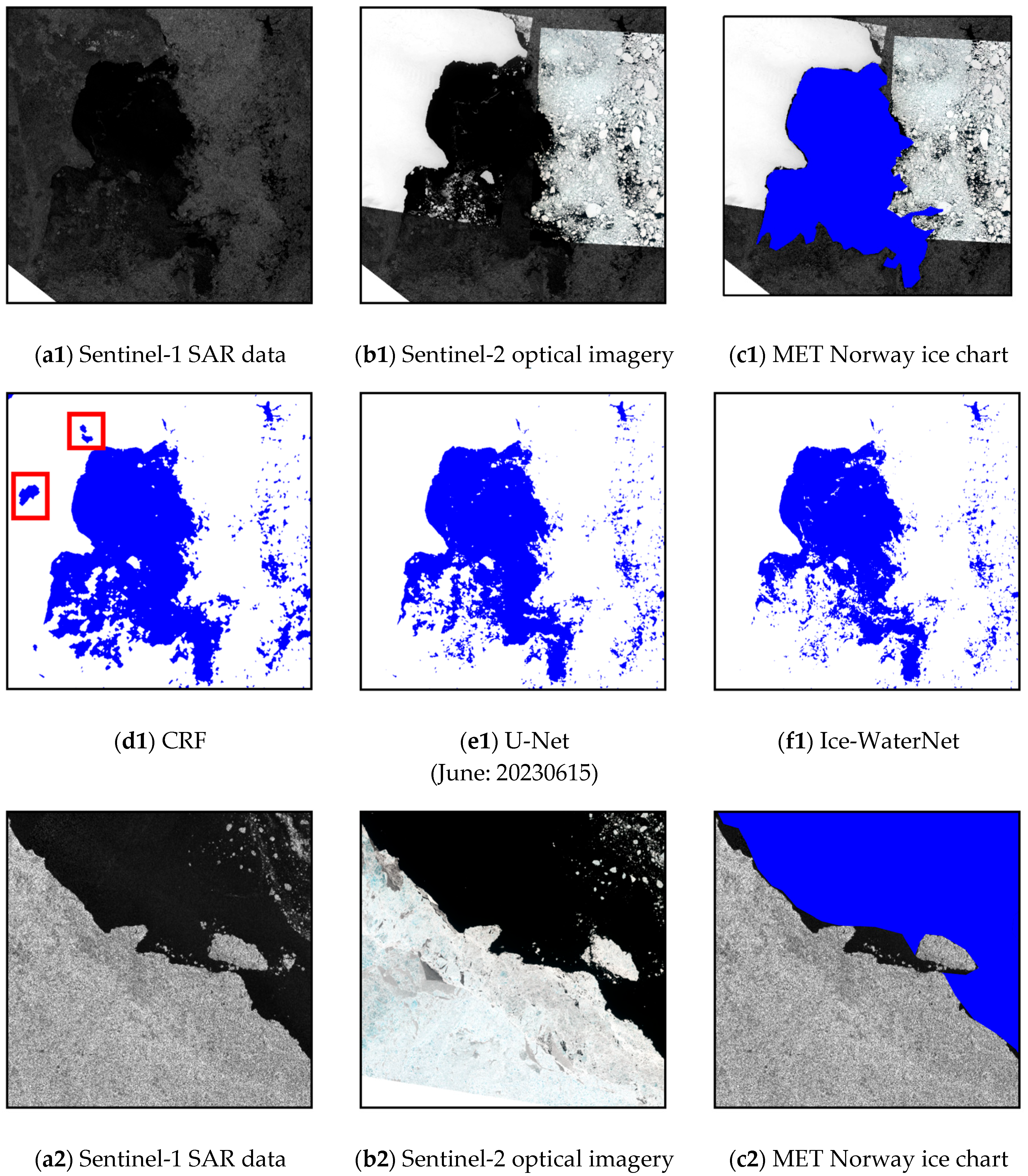
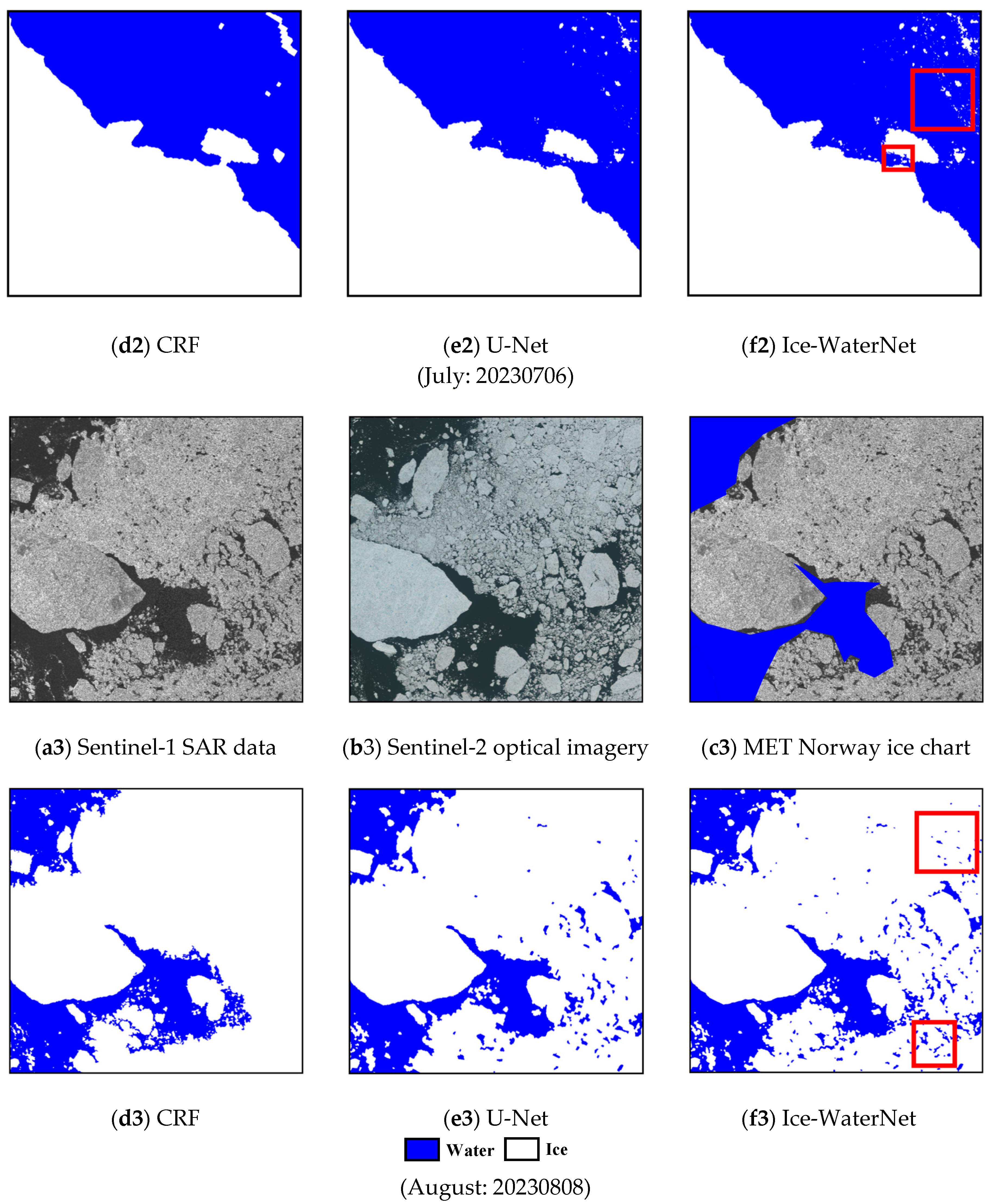

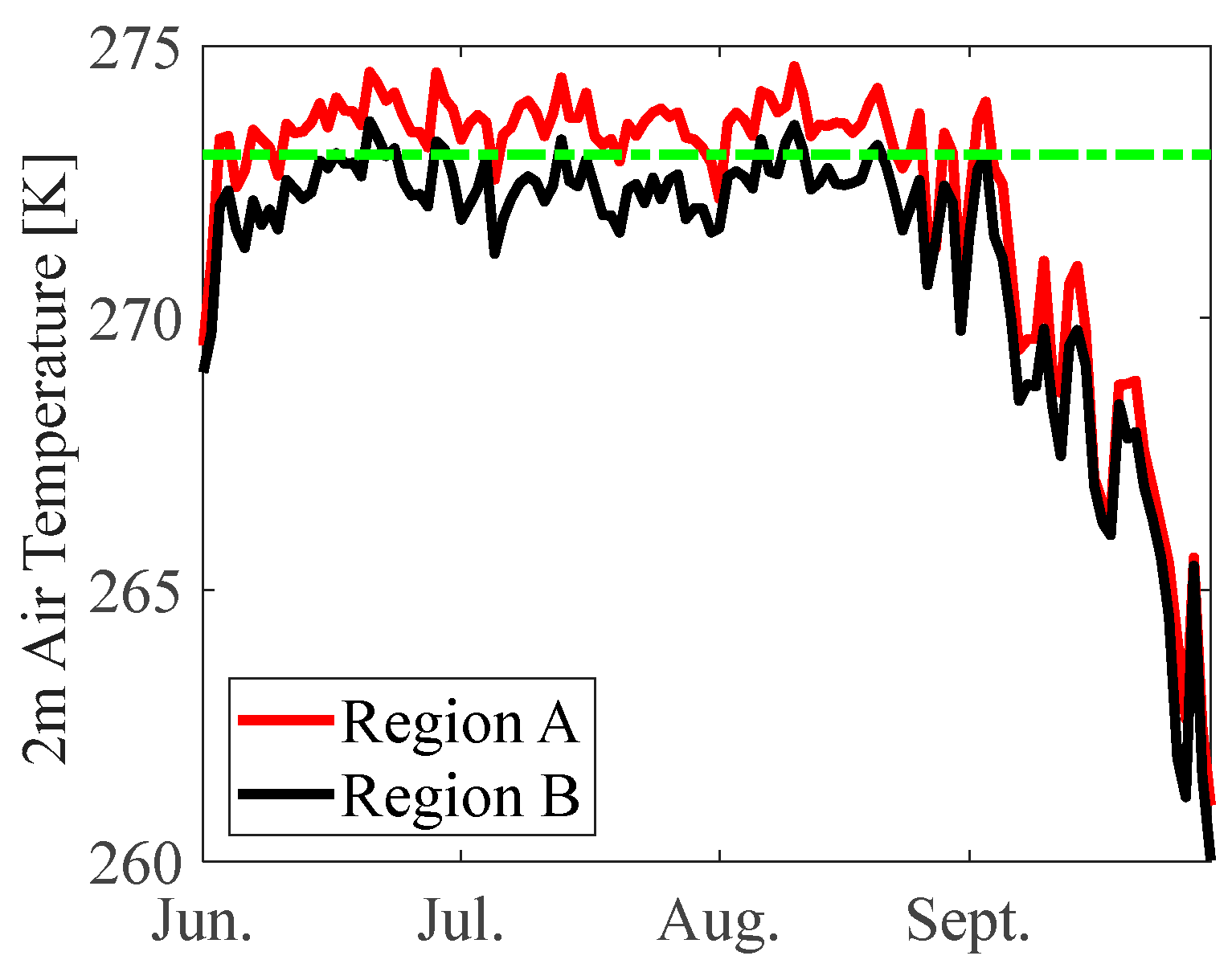
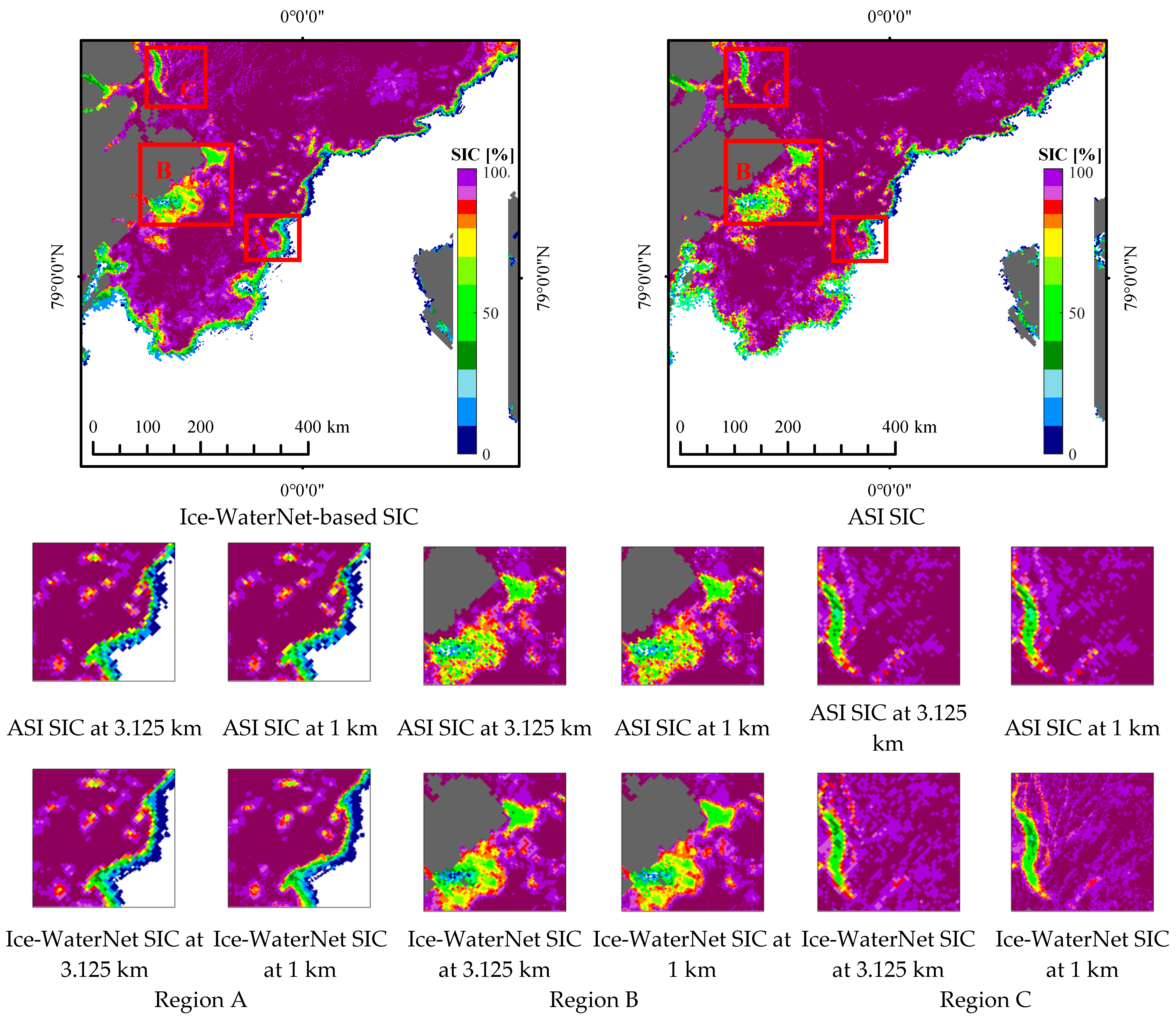
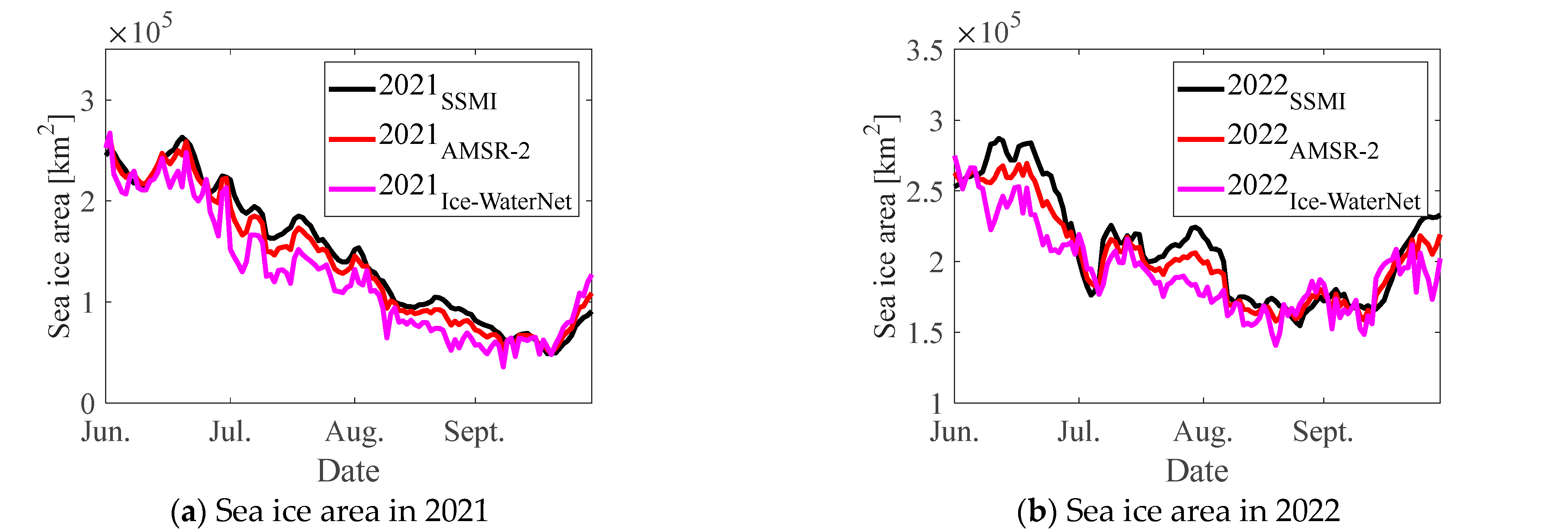
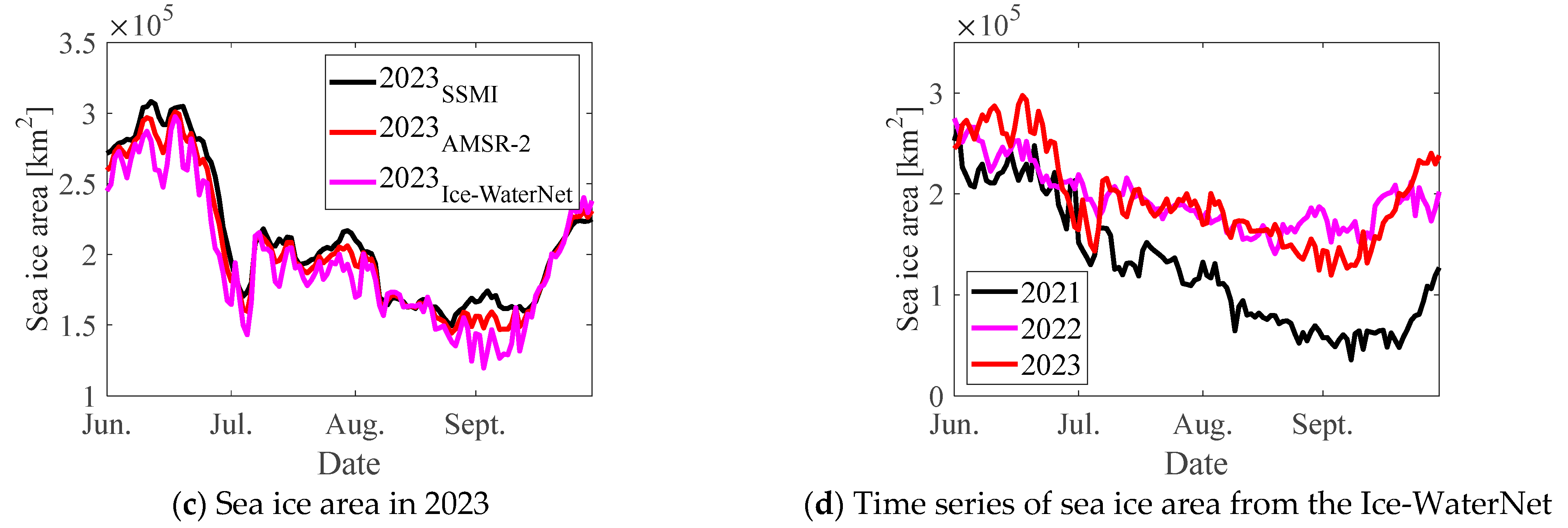
| Samples Dataset | Melt Season | Freeze Season | |||
|---|---|---|---|---|---|
| MET Norway | Manual Labeling | MET Norway | |||
| Samples for Ice-WaterNet training Patch size: 512 × 512 | Training | 48 | 52 | Training | 48 |
| Validation | 22 | 18 | Validation | 22 | |
| Testing | 20 | 20 | Testing | 20 | |
| Total | 90 | 90 | Total | 90 | |
| Freeze Season | Month | |||
|---|---|---|---|---|
| Year | December | January | February | March |
| 2021–2022 | 34 | 35 | 31 | 34 |
| 2022–2023 | 34 | 34 | 31 | 34 |
| 2023–2024 | 34 | 34 | 31 | 34 |
| Total | 102 | 103 | 93 | 102 |
| Melt Season | Month | |||
| Year | June | July | August | September |
| 2021 | 34 | 33 | 34 | 33 |
| 2022 | 34 | 33 | 34 | 33 |
| 2023 | 34 | 33 | 34 | 31 |
| Total | 102 | 99 | 102 | 97 |
| Parameter | Setting |
|---|---|
| Input channel number | 2 |
| Total training epochs | 10 |
| Epoch length | 20 |
| Patch size | 512 |
| Batch size | 12 |
| Optimizer | Adam |
| Learning rate | 0.001 |
| Weight decay | 0.0025 |
| Scheduler | StepLR |
| U-Net convolution filter number | 32, 64, 128, 256, 256 |
| Data augmentation | Random Horizontal Flip Random Vertical Flip Random Rotation Random Cropping |
| Loss function | Cross Entropy |
| Month | CRF | U-Net | Ice-WaterNet | |||||||||
|---|---|---|---|---|---|---|---|---|---|---|---|---|
| IoU | Precision | Recall | F1 | IoU | Precision | Recall | F1 | IoU | Precision | Recall | F1 | |
| June | 85.82 | 91.02 | 91.52 | 91.26 | 84.88 | 90.88 | 90.04 | 90.46 | 88.12 | 93.14 | 93.24 | 93.19 |
| July | 84.85 | 90.85 | 90.31 | 90.57 | 83.95 | 90.87 | 89.62 | 90.24 | 87.91 | 93.31 | 93.87 | 93.59 |
| August | 84.32 | 90.64 | 90.64 | 90.64 | 85.65 | 91.25 | 90.23 | 90.74 | 88.87 | 93.89 | 94.52 | 94.20 |
| September | 85.43 | 90.23 | 90.73 | 90.47 | 85.32 | 91.42 | 90.62 | 91.02 | 89.02 | 93.72 | 94.92 | 94.32 |
| December | 88.43 | 92.71 | 93.81 | 93.26 | 89.91 | 93.98 | 93.68 | 93.83 | 90.56 | 94.66 | 95.24 | 94.95 |
| January | 88.73 | 92.63 | 93.63 | 93.13 | 88.76 | 94.12 | 93.72 | 93.92 | 90.21 | 95.31 | 95.37 | 94.34 |
| February | 88.16 | 93.41 | 93.26 | 93.33 | 88.85 | 93.85 | 94.05 | 93.95 | 90.33 | 95.47 | 95.47 | 95.47 |
| March | 88.35 | 93.55 | 93.45 | 93.50 | 88.92 | 93.72 | 93.88 | 93.90 | 90.42 | 95.26 | 95.62 | 95.44 |
Disclaimer/Publisher’s Note: The statements, opinions and data contained in all publications are solely those of the individual author(s) and contributor(s) and not of MDPI and/or the editor(s). MDPI and/or the editor(s) disclaim responsibility for any injury to people or property resulting from any ideas, methods, instructions or products referred to in the content. |
© 2025 by the authors. Licensee MDPI, Basel, Switzerland. This article is an open access article distributed under the terms and conditions of the Creative Commons Attribution (CC BY) license (https://creativecommons.org/licenses/by/4.0/).
Share and Cite
Zhu, T.; Cui, X.; Zhang, Y. A High-Resolution Sea Ice Concentration Retrieval from Ice-WaterNet Using Sentinel-1 SAR Imagery in Fram Strait, Arctic. Remote Sens. 2025, 17, 3475. https://doi.org/10.3390/rs17203475
Zhu T, Cui X, Zhang Y. A High-Resolution Sea Ice Concentration Retrieval from Ice-WaterNet Using Sentinel-1 SAR Imagery in Fram Strait, Arctic. Remote Sensing. 2025; 17(20):3475. https://doi.org/10.3390/rs17203475
Chicago/Turabian StyleZhu, Tingting, Xiangbin Cui, and Yu Zhang. 2025. "A High-Resolution Sea Ice Concentration Retrieval from Ice-WaterNet Using Sentinel-1 SAR Imagery in Fram Strait, Arctic" Remote Sensing 17, no. 20: 3475. https://doi.org/10.3390/rs17203475
APA StyleZhu, T., Cui, X., & Zhang, Y. (2025). A High-Resolution Sea Ice Concentration Retrieval from Ice-WaterNet Using Sentinel-1 SAR Imagery in Fram Strait, Arctic. Remote Sensing, 17(20), 3475. https://doi.org/10.3390/rs17203475






